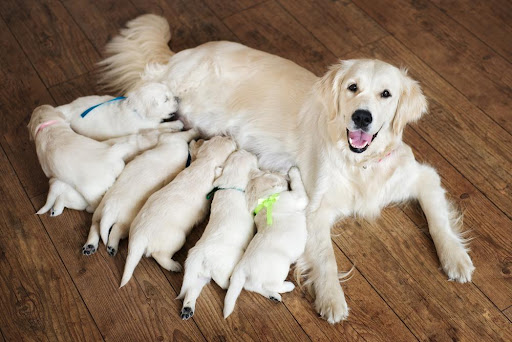9 Tips for Preparing for a Litter of Puppies

Preparing for your first litter of puppies is an exciting experience, and also an intimidating one. It involves way more prep work than simply buying some gifts for dog parents and calling it a day. Here are nine expert tips to help you prepare for a litter of puppies to ensure the smoothest experience possible for you and the mother dog
Get to know the puppy parents.
You need to be familiar with the dog breed in general as well as the specific details of both the mother and father dogs’ profiles (technically referred to as the “bitch” and the “stud,” respectively). You will want to consider not just the dogs’ individual personalities but also the history of health longevity of both their lines, going back for several generations. It’s usually a good idea to have a backup stud dog in mind in case your first choice doesn’t work out for whatever reason, and you’ll need to be prepared to negotiate a contract and pay a stud fee.
Stay on top of the mother’s health needs.
You should get the mother dog checked out by your veterinarian before breeding to ensure that she has a clean bill of health. She might need additional vaccinations prior to giving birth since she will pass antibodies to the puppies through her milk. You might need to switch to a more nutrient-dense food or to supplement her diet with vitamins and healthy treats for dogs to ensure that she has enough nutrients to support the growing pups. Some breeders also use progesterone testing to determine the best time to breed the mother dog.
Prepare a whelping box.
Once you are a couple of weeks out from the due date, create a whelping box where the mother can give birth. The box should be large enough to comfortably hold the mother plus the entire litter of puppies. It should have a raised edge to prevent the puppies from tumbling out, but it should be low enough that the mother dog can leave easily if she needs to. Make sure that whatever whelping box you create or buy has roll bars on the edges to prevent mom from accidentally lying on the puppies.
Get the word out to potential buyers.
You should start advertising your upcoming litter before the mom gives birth so that you already have a list of interested buyers ready to go once the puppies arrive. Your local veterinarian is a great resource for this, as are your friends and family who are passionate about dogs. There are also plenty of reputable online forums — such as the AKC Marketplace — which strive to match responsible dog owners with legitimate dog breeders.
Gather your birthing supplies.
As the due date draws closer, you should assemble all the supplies that you might need during the birthing process. This includes towels, blankets, newspapers, gloves, a stethoscope, disinfectant, a thermometer, and a hemostat. You will also want a scale and a notebook to record the details of each puppy at birth. For yourself, you will want a comfortable chair or futon where you can wait, as well as caffeine and snacks to keep yourself alert and awake. Have the numbers for your veterinarian and breeder on speed dial in case anything goes wrong.
Know the signs of labor.
While gestation lasts for 63 days on average, you should be ready for labor from 58 days onward. Prior to labor, the mother dog might lose her appetite and/or vomit as well as exhibit signs of restlessness. Labor usually lasts six to 12 hours but can take up to 36 hours sometimes. The first puppy should be born about an hour after active labor starts. Call your vet if it takes longer than that for the first puppy to arrive, if more than four passes between puppies, and if the mother dog shows signs of exhaustion but still hasn’t given birth to all the puppies.
Be ready for manual feeding if necessary.
Most mother dogs will be able to nurse their puppies just fine, but if she has problems post-whelping, then you need to be ready to manually feed the puppies using a milk replacer in a syringe or nursing kit. Puppies are usually ready to be weaned around four weeks of age. Start by mixing milk replacer with wet puppy food and then slowly transition them to regular food and bones for small dogs once those puppy teeth come in.
Take care of worming and vaccinations.
You will need to talk with the potential buyers about worming and vaccinating the puppies before they are ready to be adopted out around eight weeks of age. Puppies should be wormed at five, eight, and 12 weeks, and then every three months after that, so communicate with buyers about when the next worming treatment needs to be done. Your vet will let you know when the puppies can be vaccinated. Usually, they get their first shots around six to eight weeks and then another round two to three weeks after that.
Don’t forget about socialization.
Even though puppies can’t meet other dogs until they have been fully vaccinated, you should still expose them to new sights, sounds, textures, and people within the confines of your home. This will ensure that they are confident, curious, and ready to be adopted once they reach the two-month mark. Early socialization is key for ensuring that the dogs are easy to train once their new owners take them home and it will contribute to your growing reputation as a quality breeder.
What are your other tips for welcoming a litter of puppies? Are you a veteran dog breeder or are you about to welcome your very first litter of puppies? Let us know in the comments below!

